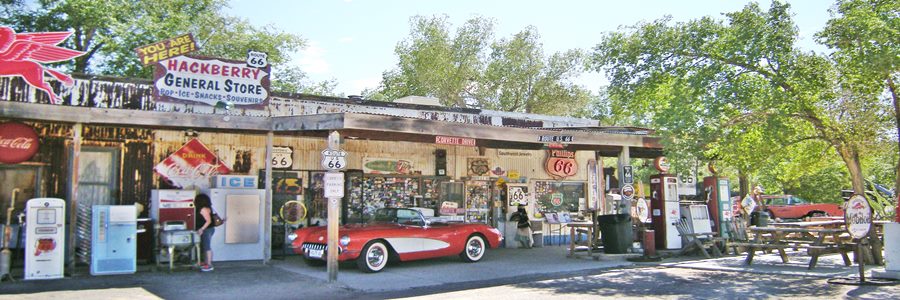Some advice for our foreign visitors on travel to America
Table of Contents
Index to this page:
- Start to Plan your Trip
- Checklist for your Trip
- To Do List
- Driving in the U.S.
- General Tips for your USA Trip
Start to Plan your Trip
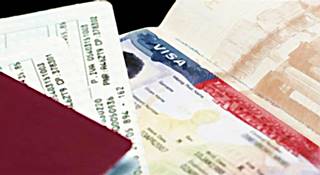
For those who live abroad, planning a Route 66 road trip requires taking into account several factors that those living in the U.S. don't need to consider, such as: flying into the US, obtaining a tavel visa, travel insurance, renting a car, and learning the local driving rules and what specific things you should take into account when visiting America.
In this page we will cover the following topics:
- A checklist for your trip to America and your Route 66 Road Trip
- The important documents you need to bring with you: passport, driver's license, US Visa (we have a separate page for Visas).
- Flying into the US (also on a separate page).
- Important tips on electricity, Driving in the US, and General Tips and information (taxes, drinking, shopping, time zones, safety, etc.)
- You will also need Travel Insurance and Rent a Car
Planning your Trip
Our website offers plenty of information so that you can plan your trip: What to see, Weather, Road Conditions, When to come, Hotel bookings, Car rentals and more!
Resources for your Trip
- Route 66 FAQ
- Road Conditions
- Weather on route 66
- When to Visit Route 66
- Rent a Car
- Rent a Motorcycle or Rent an RV
- Is it dangerous for tourists?
- Detailed description leg-by-leg with custom interactive maps of the alignments of US66, and a description of each leg from Chicago to Santa Monica.
- Itinerary along Route 66
- Tips for a Great Road Trip
Attractions & Sights
Lodging
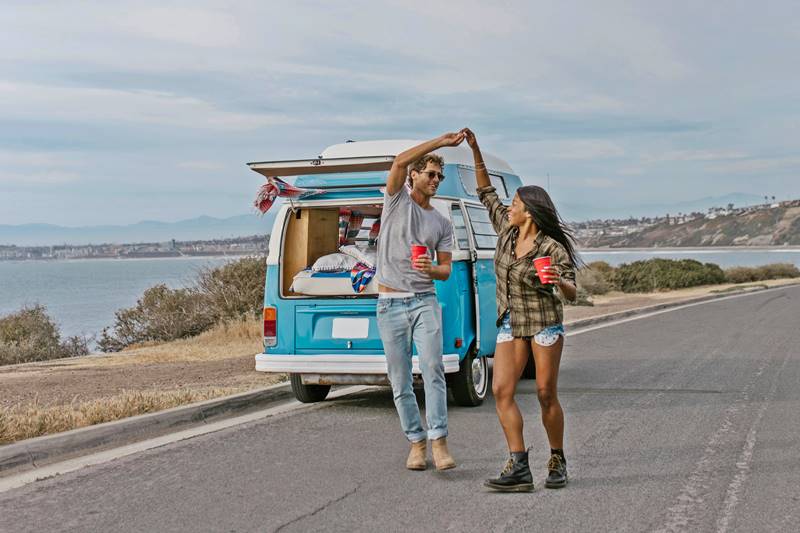
Checklist for your Trip
Things to know before you come to the US
There are some things that you must arrange before leaving home which will ensure you a smooth trip.
1. Passports
Check your passport's expiration date, you need a valid passport to travel to the U.S., if it will expire less than 6 months after your departure date from the US you will need to renew it before ou travel. Remember that it may take some time to renew your passport. Give yourself time to do so.
2. Travel Visa
You will also need a travel visa to enter America, the citizens of some countries are excepted from the visa by the Visa Waiver Program and can enter the US using an ESTA. Learn more about obtaining a US travel Visa. This may also take some time depending on your nationality (ESTAs are fast, paper visas take longer).
3. Travel Insurance
Check out the available options, compare prices and buy Travel Insurance. Check what coverage your existing insurance offers, and what additional coverage your credit cards may provide. But by all means, do not go overseas without Travel Insurance.
Costs of traveling uninsured
49% of people don't realize that they are liable to pay their own medical bills abroad.
The average medical claim is $1,500 and that every day, 10 British travelers are hospitalized abroad. America has a very costly health system, and even simple procedures, visiting a dentist or an ER entry can costs from hundreds to thousands of dollars:1
- Emergency tooth filling: $100 to $250
- ER visit: $150 to $20,000
- Sprained non-surgical wrist or ankle: $500 and up
- X-ray imaging: $400 to $2,000
4. Reservations and Bookings
If you are traveling during peak season, make sure you have your flights into the US and onwards to Route 66 are booked well in advance. On our Flying in to Route 66 page you will find useful tips and travel hacks.
Peak season travel also requires that you book your hotels in the destinations that will be more visited, and also, have your Car Rented.
5. Credit and Debit Cards
Call your credit-card companies and your Bank to let them know that you will be traveling abroad. Carry more than one card in case you have problems with the main card. Get the emergency phone numbers so that you can call them in case of loss or theft or any other problem involving your cards. Jot down their numbers for reference in case of loss.
Get the PIN code for your cards, you will need it to draw cash from ATMs overseas. Check applicable fees as they may apply. Perhaps your debit card would be a better option.
Travel perks: your credit card may earn mileage for you when you travel, or give you access to airport lounges, check this out before you travel.
Carry some cash with you, it will always come in handy.
6. Mobile Phone
Phones are part of our personal gear: we pay with them, carry our boarding passes, driving map app (Waze, Google Maps), membership cards, airline apps, and also, use them to communicate via phone or Whatsapp, mail, etc. Below are some mobile travel hacks:
- Consider an eSim, it is usually cheaper than your phone network’s data add-on packages. Check with your mobile phone provider what are the applicable roaming charges for the US and compare.
- Use free Wi-Fi at your hotel, or in cafes, but always bear in mind that these networks are not as safa as your 4G phone network.
- Carry with you a fully charged portable charger, and your adapter to plug it into the car (USB and Type-C plugs) to keep it charged. It will provide peace of mind and keep you connected. Most hotels have USB ports in the rooms, but also carry an adapter with you that has USB ports so you can plug it into the hotel room socket and charge multiple devices.
7. Documents
Our world is becoming paper free, your boarding pass can be carried in your mobile phone, and your hotel bookings in the hotel App or in your e-mail, but a "hard-copy" back-up is advisable: print and carry copies of your important travel documents. If you lose your original papers these will be very useful when you try to get new ones. Pack them separately from the originals.
These are the documents that you will need for your trip:
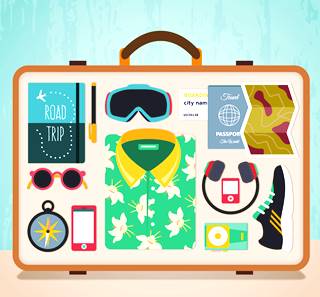
- Passports wiht the appropriate U.S. Visa
- If you are one parent travel with children you may need a letter of consent from the other parent. Check the U.S. traveling with children legal requirements.
- Credit Cards. Do you know the numbers of your cards? You will need them if you lose them. Jot them down, take a picture of photocopy them.
- International Student Identity Card (ISIC) provides students with discounts in stores and transportation.
- Driving License. You will not need an International Driving Permit in the US if it is legible (has English text).
- Travel Insurance. The contact numbers and contract should be jotted down and kept handy.
- Medicine. The American Food and Drug Administration says: "you should have with you a valid prescription or doctor’s note—written in English—to bring medication to the U.S. The medication should be in its original container with the doctor’s instructions printed on the bottle. If you don’t have the original container, bring a copy of your prescription or a letter from your doctor explaining your condition and why you need this medication. Travel with no more than you need for your personal use during your stay. A rule of thumb: Bring no more than a 90-day supply of medication." 2
- Hotel Bookings, car rental contract. Copies may be handy should a dispute arise over what you actually booked.
- Airline e-tickets. Jot down your reservation number it is useful to confirm your return or connecting flights.
To Do List
Write down your itinerary with dates and locations and give a copy to your family or friends, so that they know where you are.
Prescription Medicine. Visit your doctor and get a checkup. Get a prescription for your regular medicine (cover your entire journey).
Visit your dentist (a sore tooth on a trip is hell!), and check your contact lens stock too.
Your home: arrange for the bills to be paid, your mail picked up, or placed on hold and if you receive a newspaper, cancel it or have somebody pick it up.
Pets: will they remain at home with a sitter or board them somewhere else? Arrange for their care, and food⁄meds supply.
Things to Remember
Take your valuables and medicine with you in your carry on luggage and carry your prescription with you, the authorities may ask for it. Do not pack them in the check-in baggage during your flight. If it is lost or delayed you will lose your medications.
If you forget something at home, don't worry, you can always buy it in the US.
Check what you can and cannot carry onboard your flight, and how much you can take with you (liquids, sharp instruments, lighters, etc.) and also alcohol, fragrances and cigarettes bought at duty free shops. Connecting flights security screening will ban a 1 liter bottle of Scotch that you bought at the duty free when you left your country.
What to Bring
We have detailed a list of What to Bring Items for your USA trip and your Route 66 road trip, covering guidebooks, cameras, devices, toiletries, etc.
Things that you should not bring
Travel always entails the risk of luggage loss. So don't bring irreplaceable items with you, and definitively leave all prohibited or restricted articles at home. Some pointers:
- Expensive jewelry and irreplaceable family objects
- Unnecessary cards and papers that usually fill your wallet (travel lean).
- Credit cards that will not be used during the trip. Why risk losing them?
- Prohibited or forbidden articles (check the US government website that lists them banned agricultural items). This includes plants, seeds, coldmeats, foodstuff.
There are other items that could be restricted or banned, check them in prohibited and restricted items webpage of the Customs and Border Protection (CBP).
Driving in the U.S.
Some General Driving Rules
Each state in America has its own driving laws. So you will encounter eight different sets of traffic rules and regulations when you drive along Route 66 on your road trip. Fortunately they are mostly the same, but, there are some variations.
Check the special driving rules of the state where you rent your car. When entering a new state there are usually highway signs giving specifics. Check AAA Driving Laws or drivinglaws.org for a state by state detail.
School Buses
Children who are getting on or off school or church buses have priority over all traffic. Keep your eyes well opened for those yellow "school buses". If their lights flash yellow it means that it is going to stop. When the lights flash red, it has stopped.
All traffic must stop 20 to 25 feet (7 to 8 m) away from the bus behind it if it is in front of you, or ahead of it, if it is on the opposite side of the road. Children may cross the road. Be careful. You must remain stopped until the bus moves on or the driver indicates that you may proceed.
Never ever pass a school bus with flashing red lights, this is a serious offense you may go to jail and be fined up to $1,000.
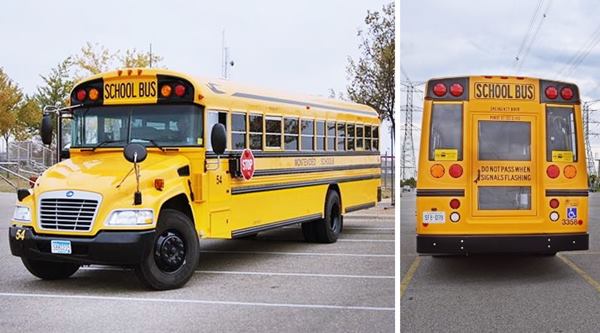
Speed Limits
Speeds in general (for highways) range from 55 to 75 mph. See detailed information at this external link: State Speed Limits (Governors Highway Safety Association).
In urban areas speeds are lower than in rural ones, be aware of the speed limits within the towns, especially close to schools. Signs will indicate the maximum (and on some highways, the minimum) speeds. One should always drive at a reasonable and prudent speed based on road and weather conditions.
- Always give cyclists a wide berth (min. 3 ft. - 1 m). Pedestrians have the right of way once they have stepped onto the crossing without traffic lights. When entering or leaving a car park yield to pedestrians.
- A solid yellow line on your side of the road means that passing is prohibited. Two solid yellow lines prohibit passing in both directions.
- In towns and especially near schools pay special attention to the speed limits.
- Do not drink and drive (read more)
- If you come to a sign stating:"Right Lane Must Turn Right" or "Exit Only", obey and do as told. Stop and Yield mean that: stop and yield.
- Flashing traffic lights: red flashing means "Stop", yellow means "Yield".
- In most states a red traffic (stop) light will allow you to take a right turn.
- Don't use mobile phone or text while driving. Don't speed. Buckle up and seat children in the back seats. Use your horn sparingly.
- Change one lane at a time and signal your intention to do so with time.
- You can turn left by using the specially designated "center Lanes"
- Four-way stops: Stop. The first to stop is the first to proceed. If you arrive at the same time as another driver, the one on the right has the right of way.
- At road work zones, follow the speed limits and flagger signals. Fines are high.
- Yield to emergency vehicles.
- Remember that school buses and vehicles carrying flammable liquids MUST stop at railroad crossings. Break in time if you are behind that type of vehicle.
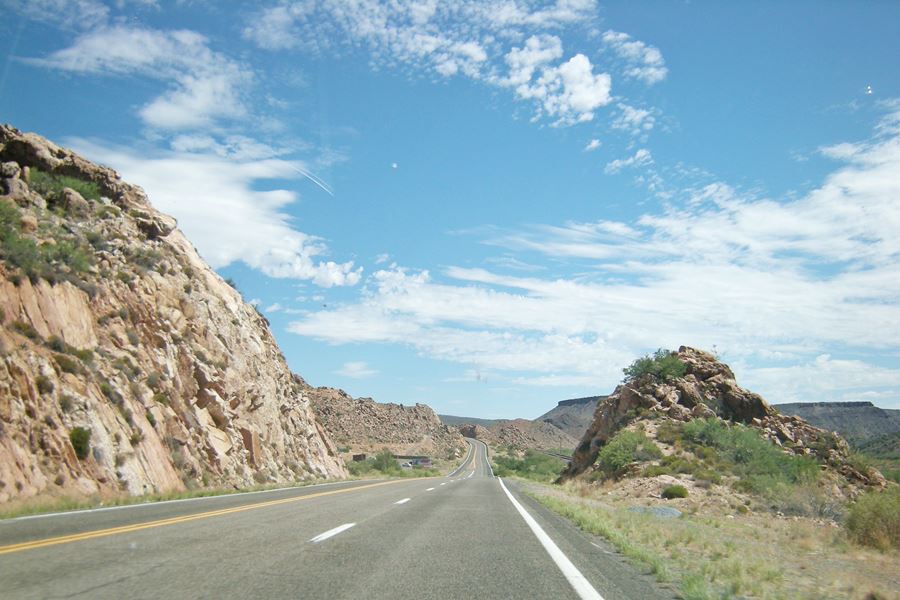
Interstate Highways
Only stop or park on the shoulder of an Interstate Highway in an emergency. When entering, yield to those on the Interstate.
Number system: odd numbers run north to south, with I-5 on the Pacific Coast and I-95 on the Atlantic Coast. The even numbers run east to west (I-94 along the Canadian border and I-8 along the Mexican one). A third digit is added near cities: a "2" passes through a city, a "4" goes around a city, a "6" goes around a Metro Region and an "8" goes through a Metropolitan region. Odd numbered hundreds digit: A "1" and a "5" are spurs into a city and a "3" is a link between two highways.
General Tips for your USA Trip
Exchange Rate
The US currency is the American Dollar, best known as the dollar. You should carry some U.S. currency with you when you enter the United States. Although you can exchange currency at the airport, the exchange rates are usually lower there than those you may find elsewhere.
Where to Exchange Currency
The best and safest places are banks and at airports. Though exchange rates at the latter are not always the best.
Check the current exchange rates online and ask about the commission charges.
ATMs
Your major bank debit or credit card will allow you to withdraw U.S. dollars at ATMs. You will be charged a fee for ATM usage by the US bank and by your bank. Fees are usually fixed so a larger withdrawal is cheaper than several smaller ones.
Visa, Amex, and MasterCard ATMs
You can locate your Visa or MasterCard ATMs with the following links:
Smoking
While in Europe and Asia, smoking is quite common; in the US smoking is not allowed in public buildings, hospitals, trains, aircraft, busses, and elevators. Ask before lighting a cigarette.
Drinking
The minimum legal age for drinking alcohol is 21 in almost all states. People under that age will not be allowed into bars or nightclubs even if they are accompanied by their parents.
Restaurants will allow underage people to enter the premises and eat, but will not serve them any alcoholic beverages.
Some states (Utah for instance) restrict the type and quantity of beverage sold in diners and restaurants. In Utah beer with more than 4% alcohol by weight has to be purchased in liquor stores.
Think twice before re-corking that bottle and carrying it in your car for you nightcaps along your journey. You cannot bring in alcoholic beverages into Utah, and that state prohibits having an open container of alcohol in the passenger compartment of a vehicle.
Closer to Route 66, the only state in which a passenger can carry an open container and ⁄ or drink from it is Missouri. In all others it is banned.
Do not Drink and Drive
Driving Under the Influence (DUI) or Driving While Intoxicated (DWI) or Operating Under the Influence (OUI), is a criminal offense.
Do not drink and drive. Alcohol and driving do not mix. Alcohol impairs your physical and mental faculties. So if your blood alcohol content is .08 or greater you will be in problems regardless of whether the alcohol has had any effect on you or not.
Drug-Impaired Driving
It's illegal everywhere in America to drive under the influence of drugs like marijuana, opioids, methamphetamines, or any potentially impairing drug.
Electric Power in the USA
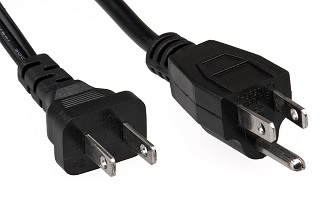
US electric plugs.
The whole country has a standard electric power supply of 110 volts and 60 cycles.
The standard electric plug is shown in the image, it has two flat blades. In some cases it may also have a third round shaped grounding pin. Make sure that you have an adapter to be able to plug in your devices or appliances.
Notebook, tablet, battery chargers and mobile phone adapters convert power covering a wide voltage range (100 - 240 V) so they should operate perfectly in the US.
Other items like electric clocks, audio equipment, hair driers, may need a power converter to work, to change the voltage from 110 to 220 volts. The US 60 Hz may also affect performance of gear designed for 50 cycles. Check that too.
Taxes
The US does not levy VAT (Value Added Tax) like European countries do. Instead there are "Sales Taxes" collected by some cities and most states with different rates.
State taxes range from 4 to 8% and city taxes are about 2%. Many items are exempt from taxation.
Buying things in America. Consdier these tips.
Clothes have a different size scale in the US, a conversion to European metric standards can be found at: Size Chart (ebay.com)
Remember that U.S. appliances are designed to be used with a power supply of 110 volts and 60 Hz. The TV and mobile phone standards may differ from those in other countries. Check before buying electronic articles.
Time Zones
America spans several time zones. From east to west they are four zones in the lower 48 states. From the Eastern zone (UTC minus 5 hours) on the eastern seabord they are aligned roughly parallel to each other. For Route 66 the Central (UTC minus 6 hours) is the first, spanning Illinois, Missouri, Kansas, Oklahoma and Texas. Next it the Mountain zone (UTC minus 7 hours) that includes New Mexico and Arizona, and finally the Pacific time zone (UTC minus 8 hours) comprising California.
There is also a daylight saving time (DST) that starts on the second Sunday in March and ends on the first Sunday in November; the time changes takes place at 2:00 AM local time. Arizona does not observe DST, but, the Navajo Nation within Arizona does, so, along Route 66 from Lupton in the east of AZ almost all the way to Holbrook there is a 1 hour difference with the rest of Arizona during DST.
Safety Tip - Big cities and crime
Some cities and towns in the Greater St. Louis metropolitan area have a very high crime rate: and this includes Venice, Granite City, St. Louis, East St. Louis and Madison.
Use common sense in this area as you would in any large city: ONLY VISIT the Route 66 sights DURING DAYTIME and then move on to stay in accommodation in the suburbs further east or west. There are many shabby districts in the Metro area with a very high crime rate. It is not advisable to spend the night there.
Drug abuse and crime rates are high. Keep off the streets at night, park in a covered garage if you can, you can park on the street but only do so if visiting for a few hours during daylight hours, don't leave valuables in your car, and know exactly where you are going because you don't want to get lost or end up in a nasty neighborhood.
Downtown Los Angeles and in Chicago are safe to walk and explore during daytime and early evening, but during nighttime don't wander off alone into solitary, unknown districts or dark alleys. Stay vigilant, and know your surroundings.
>> Learn more about risks and dangers on our Is Route 66 Dangerous? page, the potential safety risks and why it was dangerous in the past. Plus some useful safe-travel tips.
Sponsored Content
>> Book your Hotel in Santa Monica


Credits
Image Freepik
Banner image: Hackberry General Store, Hackberry, Arizona by Perla Eichenblat.

